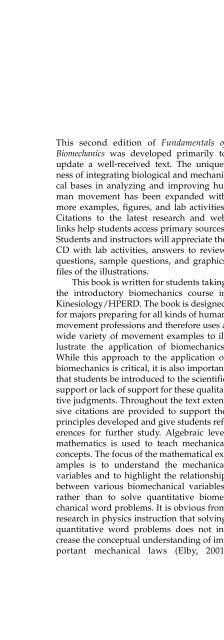Fundamentals of Biomechanics
Fundamentals of Biomechanics
Fundamentals of Biomechanics
You also want an ePaper? Increase the reach of your titles
YUMPU automatically turns print PDFs into web optimized ePapers that Google loves.
This second edition <strong>of</strong> <strong>Fundamentals</strong> <strong>of</strong><br />
<strong>Biomechanics</strong> was developed primarily to<br />
update a well-received text. The uniqueness<br />
<strong>of</strong> integrating biological and mechanical<br />
bases in analyzing and improving human<br />
movement has been expanded with<br />
more examples, figures, and lab activities.<br />
Citations to the latest research and web<br />
links help students access primary sources.<br />
Students and instructors will appreciate the<br />
CD with lab activities, answers to review<br />
questions, sample questions, and graphics<br />
files <strong>of</strong> the illustrations.<br />
This book is written for students taking<br />
the introductory biomechanics course in<br />
Kinesiology/HPERD. The book is designed<br />
for majors preparing for all kinds <strong>of</strong> human<br />
movement pr<strong>of</strong>essions and therefore uses a<br />
wide variety <strong>of</strong> movement examples to illustrate<br />
the application <strong>of</strong> biomechanics.<br />
While this approach to the application <strong>of</strong><br />
biomechanics is critical, it is also important<br />
that students be introduced to the scientific<br />
support or lack <strong>of</strong> support for these qualitative<br />
judgments. Throughout the text extensive<br />
citations are provided to support the<br />
principles developed and give students references<br />
for further study. Algebraic level<br />
mathematics is used to teach mechanical<br />
concepts. The focus <strong>of</strong> the mathematical examples<br />
is to understand the mechanical<br />
variables and to highlight the relationship<br />
between various biomechanical variables,<br />
rather than to solve quantitative biomechanical<br />
word problems. It is obvious from<br />
research in physics instruction that solving<br />
quantitative word problems does not increase<br />
the conceptual understanding <strong>of</strong> important<br />
mechanical laws (Elby, 2001;<br />
ix<br />
Preface<br />
Lawson & McDermott, 1987; Kim & Pak,<br />
2002).<br />
So why another textbook on the biomechanics<br />
<strong>of</strong> human motion? There are plenty<br />
<strong>of</strong> books that are really anatomy books<br />
with superficial mechanics, that teach mechanics<br />
with sport examples, or are sport<br />
books that use some mechanics to illustrate<br />
technique points. Unfortunately, there are<br />
not many books that truly integrate the biological<br />
and mechanical foundations <strong>of</strong> human<br />
movement and show students how to<br />
apply and integrate biomechanical knowledge<br />
in improving human movement. This<br />
book was written to address these limitations<br />
in previous biomechanics texts. The<br />
text presents a clear conceptual understanding<br />
<strong>of</strong> biomechanics and builds nine<br />
principles for the application <strong>of</strong> biomechanics.<br />
These nine principles form the applied<br />
biomechanics tools kinesiology pr<strong>of</strong>essionals<br />
need. The application <strong>of</strong> these biomechanical<br />
principles is illustrated in qualitative<br />
analysis <strong>of</strong> a variety <strong>of</strong> human movements<br />
in several contexts for the kinesiology<br />
pr<strong>of</strong>essional: physical education, coaching,<br />
strength and conditioning, and sports<br />
medicine. This qualitative analysis approach<br />
meets the NASPE Guidelines and<br />
Standards (Kinesiology Academy, 1992) for<br />
an introductory biomechanics course, and<br />
clearly shows students how biomechanical<br />
knowledge must be applied when kinesiology<br />
pr<strong>of</strong>essionals improve human movement.<br />
The text is subdivided into four parts:<br />
Introduction, Biological/Structural Bases,<br />
Mechanical Bases, and Applications <strong>of</strong><br />
<strong>Biomechanics</strong> in Qualitative Analysis. Each






